Updated T2K measurements of muon neutrino and antineutrino disappearance using 3.6E21 protons on target
Muon neutrino and antineutrino disappearance probabilities are identical in the standard three-flavor neutrino oscillation framework, but CPT violation and non-standard interactions can violate this symmetry. In this work we report the measurements of sin2θ23 and Δm232 independently for neutrinos and antineutrinos. The aforementioned symmetry violation would manifest as an inconsistency in the neutrino and antineutrino oscillation parameters. The analysis discussed here uses a total of 1.97E21 and 1.63E21 protons on target taken with a neutrino and antineutrino beam respectively, and benefits from improved flux and cross-section models, new near detector samples and more than double the data reducing the overall uncertainty of the result. No significant deviation is observed, consistent with the standard neutrino oscillation picture.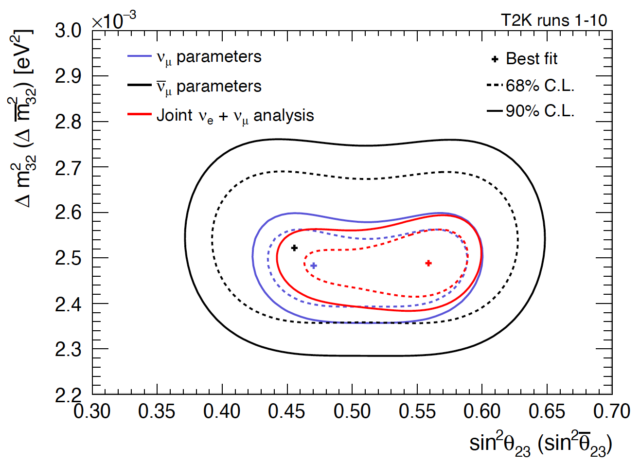
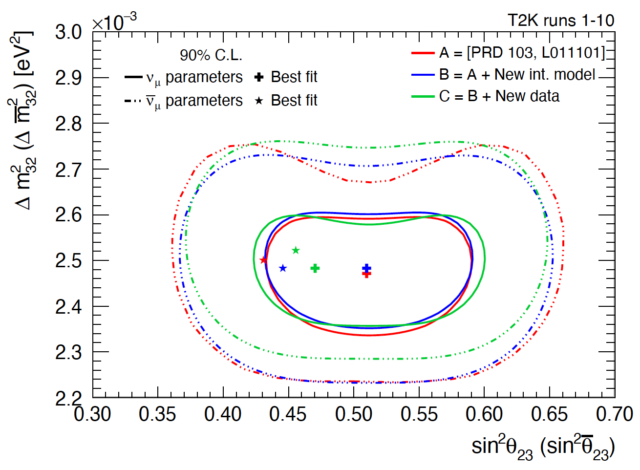
Measurements of neutrino oscillation parameters from the T2K experiment using 3.6E21 protons on target
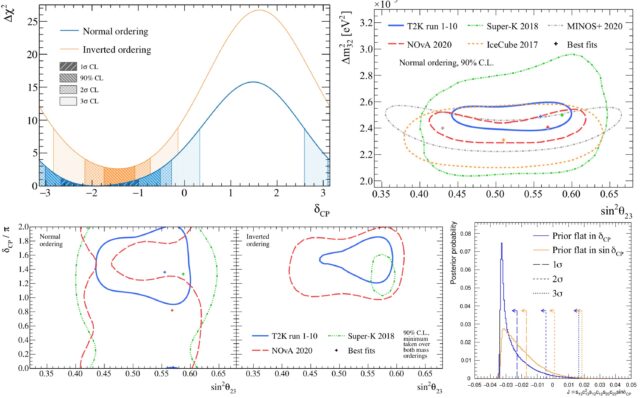
Search for Electron Antineutrino Appearance in a Long-baseline Muon Antineutrino Beam
Electron antineutrino appearance is measured by the T2K experiment in an accelerator-produced antineutrino beam, using additional neutrino beam operation to constrain parameters of the Pontecorvo-Maki-Nakagawa-Sakata (PMNS) mixing matrix. T2K observes 15 candidate electron antineutrino events with a background expectation of 9.3 events. Including information from the kinematic distribution of observed events, the hypothesis of no electron antineutrino appearance is disfavored with a significance of 2.40σ and no discrepancy between data and PMNS predictions is found. A complementary analysis that introduces an additional free parameter which allows non-PMNS values of electron neutrino and antineutrino appearance also finds no discrepancy between data and PMNS predictions.
Improved constraints on neutrino mixing from the T2K experiment with 3.13×10E21 protons on target
The T2K experiment reports updated measurements of neutrino and antineutrino oscillations using both appearance and disappearance channels. This result comes from an exposure of 14.9(16.4)×10E20 protons on target in neutrino (antineutrino) mode. Significant improvements have been made to the neutrino interaction model and far detector reconstruction. An extensive set of simulated data studies have also been performed to quantify the effect interaction model uncertainties have on the T2K oscillation parameter sensitivity. T2K performs multiple oscillation analyses that present both frequentist and Bayesian intervals for the Pontecorvo-Maki-Nakagawa-Sakata parameters. For fits including a constraint on sin2θ13 from reactor data and assuming normal mass ordering T2K measures sin2θ23=0.53-0.04+0.03 and Δm322=(2.45±0.07)×10-3 eV2 c-4. The Bayesian analyses show a weak preference for normal mass ordering (89% posterior probability) and the upper sin2θ23 octant (80% posterior probability), with a uniform prior probability assumed in both cases. The T2K data exclude CP conservation in neutrino oscillations at the 2σ level.
T2K measurements of muon neutrino and antineutrino disappearance using 3.13E21 protons on target
We report measurements by the T2K experiment of the parameters θ23 and Δm322, which govern the disappearance of muon neutrinos and antineutrinos in the three-flavor PMNS neutrino oscillation model at T2K’s neutrino energy and propagation distance. Utilizing the ability of the experiment to run with either a mainly neutrino or a mainly antineutrino beam, muon-like events from each beam mode are used to measure these parameters separately for neutrino and antineutrino oscillations. Data taken from 1.49×1021 protons on target (POT) in neutrino mode and 1.64×1021 POT in antineutrino mode are used. The best-fit values obtained by T2K were sin2(θ23)=0.51-0.07+0.06(0.43-0.05+0.21) and Δm322=2.47-0.09+0.08(2.50-0.13+0.18)×10-3 eV2/c4 for neutrinos (antineutrinos). No significant differences between the values of the parameters describing the disappearance of muon neutrinos and antineutrinos were observed. An analysis using an effective two-flavor neutrino oscillation model where the sine of the mixing angle is allowed to take nonphysical values larger than 1 is also performed to check the consistency of our data with the three-flavor model. Our data were found to be consistent with a physical value for the mixing angle.
Constraint on the matter–antimatter symmetry-violating phase in neutrino oscillations
Nature Nature 580, 339–344 (2020)
The charge-conjugation and parity-reversal (CP) symmetry of fundamental particles is a symmetry between matter and antimatter. Violation of this CP symmetry was first observed in 19641, and CP violation in the weak interactions of quarks was soon established2. Sakharov proposed3 that CP violation is necessary to explain the observed imbalance of matter and antimatter abundance in the Universe. However, CP violation in quarks is too small to support this explanation. So far, CP violation has not been observed in non-quark elementary particle systems. It has been shown that CP violation in leptons could generate the matter–antimatter disparity through a process called leptogenesis4. Leptonic mixing, which appears in the standard model’s charged current interactions5,6, provides a potential source of CP violation through a complex phase δCP, which is required by some theoretical models of leptogenesis7,8,9. This CP violation can be measured in muon neutrino to electron neutrino oscillations and the corresponding antineutrino oscillations, which are experimentally accessible using accelerator-produced beams as established by the Tokai-to-Kamioka (T2K) and NOvA experiments10,11. Until now, the value of δCPhas not been substantially constrained by neutrino oscillation experiments. Here we report a measurement using long-baseline neutrino and antineutrino oscillations observed by the T2K experiment that shows a large increase in the neutrino oscillation probability, excluding values of δCP that result in a large increase in the observed antineutrino oscillation probability at three standard deviations (3σ). The 3σ confidence interval for δCP, which is cyclic and repeats every 2π, is [−3.41, −0.03] for the so-called normal mass ordering and [−2.54, −0.32] for the inverted mass ordering. Our results indicate CP violation in leptons and our method enables sensitive searches for matter–antimatter asymmetry in neutrino oscillations using accelerator-produced neutrino beams. Future measurements with larger datasets will test whether leptonic CP violation is larger than the CP violation in quarks.
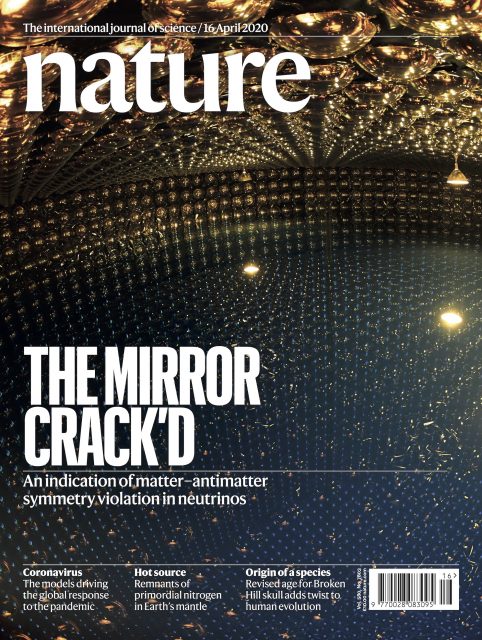
Search for CP violation in Neutrino and Antineutrino Oscillations by the T2K experiment with 2.2E21 protons on target
The T2K experiment measures muon neutrino disappearance and electron neutrino appearance in accelerator-produced neutrino and antineutrino beams. With an exposure of 14.7(7.6)×1020 protons on target in (anti)neutrino mode, 89 electron neutrino candidates and 7 electron antineutrino candidates were observed while 67.5 and9.0 are expected for δCP=0 and normal mass ordering. The obtained 2σ confidence interval for the CP violating phase, δCP , does not include the CP-conserving cases (δCP=0, π). The best-fit values of other parameters are sin^2_θ23 = 0.526+0.032 −0.036 and ∆m^2_32 = 2.463 ± 0.065E−3 eV2/c4 .
Published in Phys.Rev.Lett. 121 (2018) no.17, 171802
DOI: 10.1103/PhysRevLett.121.171802
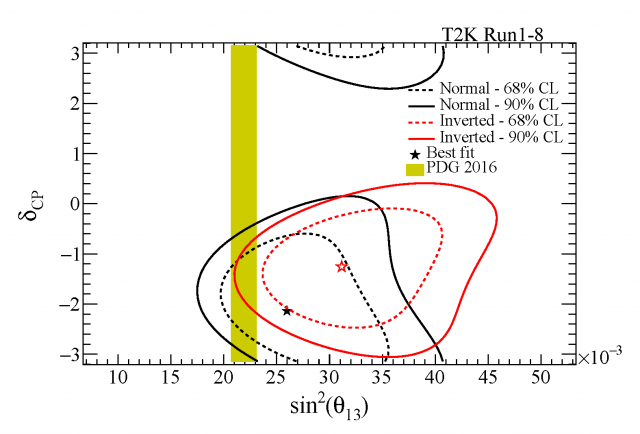
Updated T2K measurements of muon neutrino and antineutrino disappearance using 1.5e21 protons on target
English:
We report measurements by the T2K experiment of the parameters θ23 and ∆m232 governing the disappearance of muon neutrinos and antineutrinos in the three flavor neutrino oscillation model. Utilizing the ability of the experiment to run with either a mainly neutrino or a mainly antineutrino beam, the parameters are measured separately for neutrinos and antineutrinos. Using 7.482 × 1020 POT in neutrino running mode and 7.471 × 1020 POT in antineutrino mode, T2K obtains sin2(θ23) = 0.51+0.08−0.07 and ∆m232 = 2.53+0.15−0.13 × 10−3 eV2/c4 for neutrinos, and sin2(θ̅23) = 0.47+0.25−0.07 and ∆m̅232 = 2.55+0.33−0.27 × 10−3 eV2/c4 for antineutrinos (assuming normal mass ordering). No significant differences between the values of the parameters describing the disappearance of muon neutrinos and antineutrinos were observed.
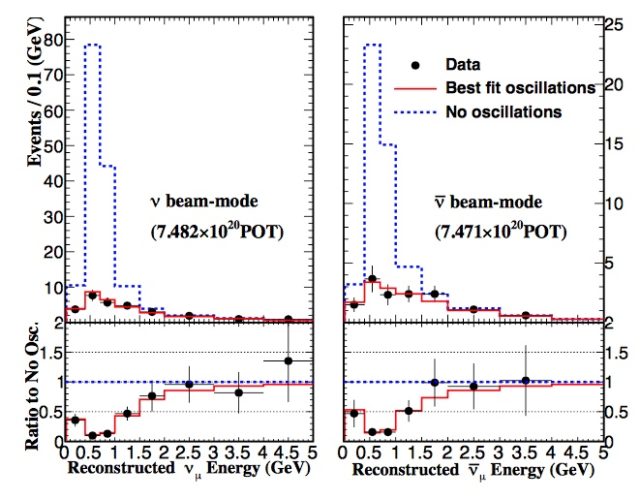
Top panels show the reconstructed energy distribution of the 135 far detector νμ-CCQE candidate events (left) and 66 ν̅μ-CCQE candidate events (right), with predicted spectra for best fit and no oscillation cases. Bottom panels show the ratio to unoscillated predictions.
日本語:
We report measurements by the T2K experiment of the parameters θ23 and ∆m232 governing the disappearance of muon neutrinos and antineutrinos in the three flavor neutrino oscillation model. Utilizing the ability of the experiment to run with either a mainly neutrino or a mainly antineutrino beam, the parameters are measured separately for neutrinos and antineutrinos. Using 7.482 × 1020 POT in neutrino running mode and 7.471 × 1020 POT in antineutrino mode, T2K obtains sin2(θ23) = 0.51+0.08−0.07 and ∆m232 = 2.53+0.15−0.13 × 10−3 eV2/c4 for neutrinos, and sin2(θ̅23) = 0.47+0.25−0.07 and ∆m̅232 = 2.55+0.33−0.27 × 10−3 eV2/c4 for antineutrinos (assuming normal mass ordering). No significant differences between the values of the parameters describing the disappearance of muon neutrinos and antineutrinos were observed.

Top panels show the reconstructed energy distribution of the 135 far detector νμ-CCQE candidate events (left) and 66 ν̅μ-CCQE candidate events (right), with predicted spectra for best fit and no oscillation cases. Bottom panels show the ratio to unoscillated predictions.
Combined Analysis of Neutrino and Antineutrino Oscillations at T2K
T2K reports its first results in the search for CP violation in neutrino oscillations using appearance and disappearance channels for neutrino- and antineutrino-mode beam. The data include all runs from Jan 2010 to May 2016 and comprise 7.482×10207.482×1020,protons on target in neutrino mode, which yielded in the far detector 32 e-like and 135 μμ-like events, and 7.471×10207.471×1020,protons on target in antineutrino mode which yielded 4 e-like and 66 μμ-like events. Reactor measurements of sin22θ13sin22θ13 have been used as an additional constraint. The one-dimensional confidence interval at 90% for δCPδCP spans the range (−3.13−3.13, −0.39−0.39) for normal mass ordering. The CP conservation hypothesis (δCP=0,πδCP=0,π) is excluded at 90% C.L.
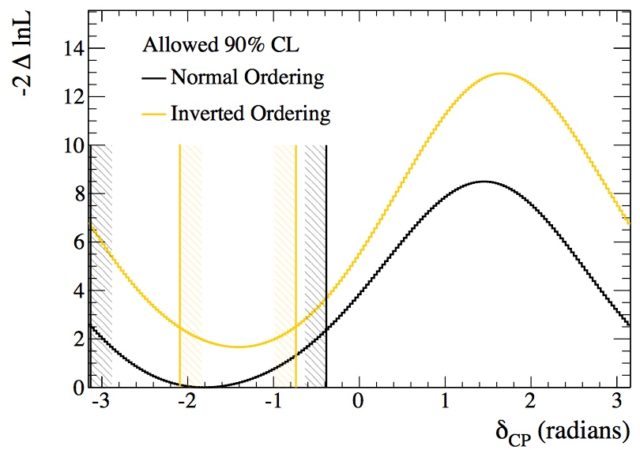
Measurement of Muon Antineutrino Oscillations with an Accelerator-Produced Off-Axis Beam
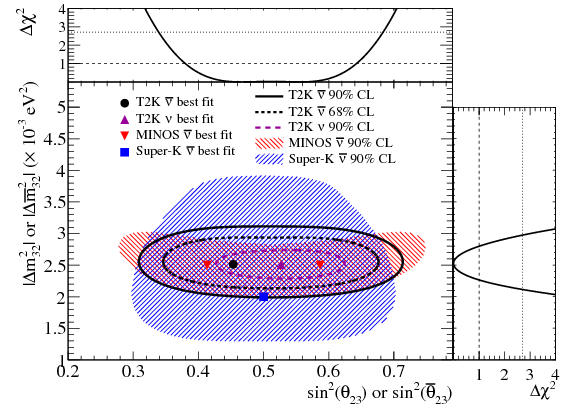
T2K reports its first measurements of the parameters governing the disappearance of ν̅μ in an off-axis beam due to flavor change induced by neutrino oscillations. The quasimonochromatic ν̅μ beam, produced with a peak energy of 0.6 GeV at J-PARC, is observed at the far detector Super-Kamiokande, 295 km away, where the ν̅μ survival probability is expected to be minimal. Using a data set corresponding to 4.01×1020 protons on target, 34 fully contained μ-like events were observed. The best-fit oscillation parameters are sin2(θ̅23)=0.45 and |Δm̅232|=2.51×10−3 eV2 with 68% confidence intervals of 0.38–0.64 and 2.26–2.80×10−3 eV2, respectively. These results are in agreement with existing antineutrino parameter measurements and also with the νμ disappearance parameters measured by T2K.


